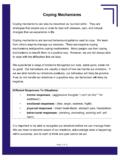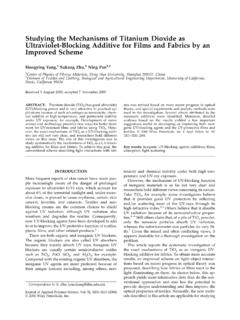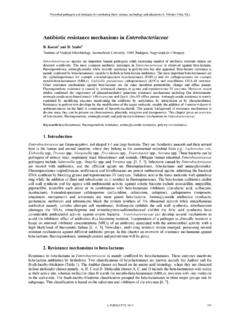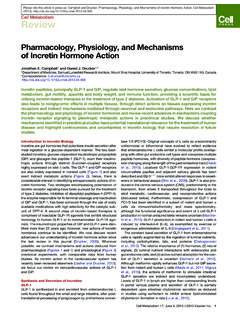Transcription of Introduction to Mechanisms and Kinematics
1 Introduction to Mechanisms and Kinematics Basic Definitions Machines are devices used to accomplish work. A mechanism is the heart of a machine. It is the mechanical portion of a machine that has the function of transferring motion and forces from a power source to an output. Mechanisms are assemblage of rigid members (links) connected together by joints (also referred to as Mechanical linkage or linkage). o Links are the individual parts of the mechanism. They are considered rigid bodies and are connected with other links to transmit motion and force. Elastic parts, such as springs, are not rigid and, therefore, are not considered links.
2 They have no effect on the Kinematics of a mechanism and are usually ignored during kinematic analysis. They do supply forces and must be included during the dynamic force portion of analysis Example The adjustable height platform (on the right) is driven by hydraulic cylinders. Although the entire device could be called a machine, the parts that take the power from the cylinders and drive the raising and lowering of the platform are Mechanisms . o A joint is a movable connection between links and allows relative motion between the links.
3 Some common joints Joint Description Revolute, pin or hinge Allows pure rotation between the two links that it connects. Sliding, piston or prismatic Allows linear sliding between the links that it connects Screw joint Permits two relative but dependent motions between the links being joined. Pin in a slot Joint Permits the two links to slide and rotate relative to one another Cam Allows for both rotation and sliding between the two links that it connects. Because of the complex motion permitted, the cam connection is called a higher-order joint, also called half join Gear A gear connection also allows rotation and sliding between two gears as their teeth mesh.
4 A simple link is a rigid body that contains only two joints, which connect it to other links. A complex link is a rigid body that contains more than two joints. Kinematic Diagram Kinematic analysis involves determination of position, displacement, rotation, speed, velocity, and acceleration of a mechanism. In analyzing the motion of a mechanism, it is often convenient to represent the parts in skeleton form (also referred to as kinematic diagram) so that only the dimensions that affect the motion are shown. A standard representation is used for the components of a mechanism as listed in the table.
5 Component Typical form Kinematic representation Simple link Simple link with point of interest Complex link Pin joint Slider joint Screw joint Pin in a slot joint Cam joint Gear Joint A kinematic diagram should be drawn to a scale proportional to the actual mechanism. For convenient reference, the links are numbered, starting with the frame, which serves as the frame of reference for the motion of all other parts. To avoid confusion, the joints should be lettered. Examples o In the first diagram, the motion of the bar handle is a point of interest o In the second diagram, the motion of the end of the bottom jaw and the lower handle are points of interest.
6 Typical form Kinematic representation Mobility The degree of freedom of a linkage is the number of independent inputs required to precisely position all links of the mechanism with respect to the frame. It can also be defined as the number of actuators needed to operate the mechanism. The number of degrees of freedom of a mechanism is also called the mobility, and it is given the symbol (M). When the configuration of a mechanism is completely defined by positioning one link, that system has one degree of freedom. Mobility in the planar case A body moving freely in planar motion has three degrees of freedom (two translations on the plane and one rotation about an axis perpendicular to the plane).
7 Suppose that in a given linkage there are (n) links. If they're all free to move independently, the system has Mobility (M = 3n). If one link is chosen as the frame link, it is fixed to the base reference frame and loses all its degrees of freedom. Therefore, the total Mobility of the system is (M = 3(n-1) ). If a joint with connectivity fi (fi degrees of freedom of the joint) is formed between two bodies the mobility of the system is diminished since those two bodies originally had three degrees of freedom of motion relative to one another. After formation of the joint they have only fi degrees of freedom of relative motion.
8 Hence the reduction in the system mobility is 3 fi. Example Without the pin joint, each link has 3 degrees of freedom. The pin joint however only allows free relative rotation (one degree of freedom) between the links. Relative translation is omitted (two free translations were omitted) If joints continue to be formed until there are j joints, the loss of system mobility is (3 ) =1 The total mobility of the linkage then becomes =3( 1) (3 ) =1 The above equation can be put in a simpler form also known as the Gruebler equation =3( 1) 2 Where is the total number of links in the mechanism is the number of primary joints (pins or sliding joints) is the number of higher order joints (cam or gear joints)
9 Examples Typical form Kinematic representation n = 4 (four members), one of the members is frame, 4 pin joints with one degree of freedom =3(4 1) (3 1) (3 1) (3 1) (3 1)=3(4 1) 4(2)=1 Typical form Kinematic representation n = 4 (four members), one of the members is frame, 3 pin joints with one degree of freedom and one slider joint with one degree of freedom =3(4 1) (3 1) (3 1) (3 1) (3 1)=3(4 1) 4(2)=1 Typical form Kinematic representation n = 3 (three members), one of the members is frame, 2 pin joints with one degree of freedom and one higher order joint =3(3 1) (3 1) (3 1) (3 2)=1 Notes: Because the mobility equation pays no attention to link size or shape, it can give misleading results in the face of unique geometric configurations.
10 For instance Using the mobility equation we find =3(5 1) 6(3 1)=0 Because the nodes are equi-spaced and the three links are of equal length, the mobility of the mechanism is equal to 1 rather than 0 Assuming enough friction between the wheels to allow for rolling without slipping, the joint between the wheels has one degree of freedom. Using the mobility equation we get =3(3 1) 3(3 1)=0 The linkage however has one degree of freedom When three links come together at a common pin, the joint must be modeled as two pins =3(6 1) 6(3 1) (3 1)=1 Actuators and Drivers In order to operate a mechanism, an actuator, or driver device, is required to provide the input motion and energy.







